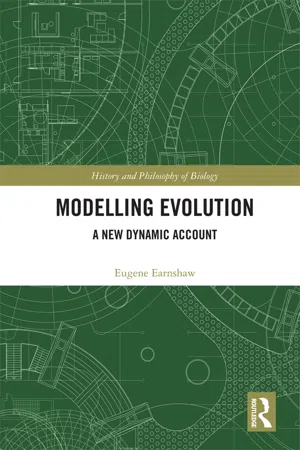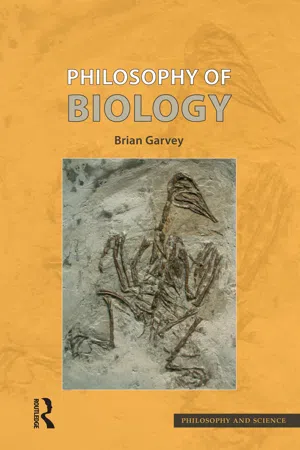Biological Sciences
Biological Fitness
Biological fitness refers to an organism's ability to survive and reproduce in a given environment. It is a measure of how well an organism is adapted to its surroundings and how successful it is in passing on its genes to the next generation. Fitness is influenced by various factors such as physical traits, behavior, and reproductive success.
Written by Perlego with AI-assistance
Related key terms
3 Key excerpts on "Biological Fitness"
- eBook - ePub
Modelling Evolution
A New Dynamic Account
- Eugene Earnshaw-Whyte(Author)
- 2018(Publication Date)
- Routledge(Publisher)
I hope it is obvious that this ‘shooting skill’ trait is a lot like ‘individual fitness’. We can’t observe it directly, any number we assign to it is never going to be entirely legitimate, and one might question whether it corresponds to any real physical thing. We have to continually bear this in mind: individual fitness is such a central concept in evolution that it is easy to forget how elusive and ephemeral it is.Nevertheless, individual fitness seems to play a key role in explaining something that is absolutely true. Because even though we cannot really measure the chances of even a single dandelion seed thriving, we know that some seeds have better chances than others. Biologists regularly find evidence that even tiny measurable differences between living things have meaningful impacts on their survival and reproduction. Birds with slightly longer or shorter beaks, seeds with slightly thicker shells, different colours on snails: all may cause different evolutionary success. So even though we can hardly know what the actual fitness values are, we can still see that the real physical variations between individuals make a real difference to how well they thrive in nature. And by representing these differences in fitness, we can begin to represent evolutionary change by natural selection.The fitness of an individual is, as we have seen, a quite elusive and difficult property, and there is no absolute objective value of individual fitness that is out there for us to find, any more than there is an absolute objective value to my chance of hitting a three point shot. It is always relative to circumstances, and so at the very least will depend on what we take the environment, or range of possible environments, to be. It is not the ACTUAL environment experienced by the individual, because some of this will be happenstance. Whatever value of individual fitness we assign will always, therefore, be a constructed value relative to certain interests or assumptions about the relevant environment. It will be an estimate for some assumed range of possible circumstances. If it is derived from empirical data, it will be relative to the circumstances that were prevalent during the time of observation, which could change and might not be representative of ‘typical’ environments, even for that place and time. All we can directly observe is an organism’s actual success in the environment it happened to live in. - eBook - ePub
Ache Life History
The Ecology and Demography of a Foraging People
- Kim Hill, A.Magdalena Hurtado(Authors)
- 2017(Publication Date)
- Routledge(Publisher)
In this book we draw explicitly from evolutionary biology and from a knowledge of mammalian mortality and fertility patterns, and the factors that affect them, in order to make “biological sense” out of the observed Ache demographic patterns. As evolutionary biologists, we are specifically concerned with the functional significance of the traits being observed. In other words we take the parameters that we have measured as design features of the organism (Williams 1966) and want to know, for example, “why a population of individuals shows the fertility and mortality profile that they do (rather than feasible alternative patterns), and what are the implications of such patterns for other behaviors that characterize that population.” We assume that demographic patterns are produced by the sum of individual behaviors, and that behaviors, just like morphological and physiological traits, are phenotypes of the organism. We recognize that organisms are generally expected to show behavioral phenotypes that maximize their genetic contribution to the gene pool (fitness).The expectation of fitness maximization for phenotypic traits is a logical deduction of natural selection acting under simple circumstances with plenty of time and variation. As Darwin pointed out, any biological trait that (1) showed heritable variation and (2) was associated with differential reproduction would always evolve through natural selection. We recognize that other forces of biological change (e.g., drift) may at times be more important than natural selection, and many useful hypothetical adaptations may never arise owing to lack of appropriate genetic variation. In addition, some traits are expected to be the inevitable side effects of other desirable traits due to genetic or phenotypic pleiotropy, but in general, most organisms should come to be characterized by phenotypes that result in higher fitness than would be characteristic of other feasible alternative phenotypes. We also recognize, however, that natural selection may often produce phenotypic “rules of thumb” that approximate perfect adaptive phenotypes under most conditions and require much less costly biological machinery than would be needed to achieve a perfect adaptive fit to the environment. In any case, the expectation that phenotypes should be approximately optimal (i.e., fitness maximizing) is a useful starting point for learning about biological design function (Parker and Maynard Smith 1990).The assumption that behavior can be treated just like morphology, physiology, or any other organism phenotype is based on the realization that all behaviors are produced by organic components of the body. The central nervous system, the peripheral nervous system, hormones, blood chemistry, muscles, etc., all act in sequence and in concert to produce behavioral patterns. All these organic components are in turn produced by proteins for which instructions are encoded on the DNA sequence of an organism. Changes in DNA sequences can therefore directly affect behavioral patterns, and thus all behaviors and behavioral tendencies have a heritable component (although a particular behavioral variation may not be heritable). More important, basic goals and desires which motivate behavioral decisions are themselves a product of the central nervous system and therefore must be affected by natural selection. - eBook - ePub
- Brian Garvey(Author)
- 2014(Publication Date)
- Routledge(Publisher)
B.To be fair to Rottschaefer and Martinsen, they write elsewhere in the same paper that "the robust Darwinian includes among the multiple moral goods those things and states of affairs that normally promote human adaptations, fitness and survival and reproduction" (ibid .: 393, emphasis added), implying that fitness is not the sole moral good. Nonetheless we must ask: is it plausible to think of fitness as a moral good at all?Let us say that "pursue evolutionary fitness" was treated as a moral maxim. What kind of behaviour would it prescribe? It would not prescribe simple selfishness, as it would at the very least require us to look after our offspring, and to be prepared to make the ultimate sacrifice for them in certain circumstances. But the key term here is "in certain circumstances". Suppose a creature is able to distinguish between offspring that themselves have good reproductive prospects and those that do not. Let us say, for example, that some offspring are weak and sickly and have poor prospects of surviving long enough to produce many offspring. Or let us say that some of them are much better looking than others - by whatever the relevant standard of better looking is - so that it has a better chance of attracting mates. (In the case of a peacock, it would mean having a more elaborate tail.) From the perspective of evolutionary fitness, it would make sense to put more resources into the stronger, or the better looking, offspring, than into the weaker, uglier one. In an extreme case, putting resources into the weaker one is simply a waste: better to let it starve. Similar reasoning would apply to one's mate. In many species, the two parents share the job of providing for their offspring. Clearly, the two parents have a shared interest in seeing to it that their offspring are provided for. It is, therefore, in both their interests to stay together to look after their offspring. Once again, however, this is only in certain circumstances. The possibility could arise of finding a better mate: one who is more fertile, better able to provide resources for offspring, liable to produce offspring who themselves are healthier, or something along those lines. In such circumstances, the evolutionarily fit thing to do might be to leave one's current mate, literally, holding the baby.
Learn about this page
Index pages curate the most relevant extracts from our library of academic textbooks. They’ve been created using an in-house natural language model (NLM), each adding context and meaning to key research topics.


